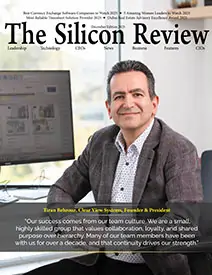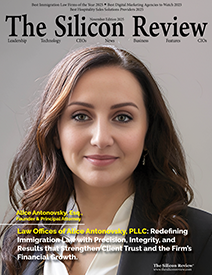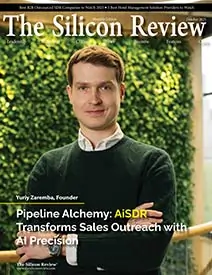EchoNous – Creating a Vibrant and Evolving Ecosystem of Thoughtfully Designed AI Tools for the Healthcare Community – and its Patients’ Most Pressing Needs
The Silicon Review
![]()
“Our primary offerings are hardware AI applications in the form of algorithms and then software. Beyond that, we have all of our products at five-year warranties. We are focused on keeping the cost of ownership down.”
Known as the “Swiss Army knife” of healthcare, point-of-care ultrasound—or POCUS—has come a long way. It can do a lot—in a lot of different settings. Perhaps that’s why clinicians and administrators have embraced point-of-care ultrasound (POCUS) ever since it arrived in clinical settings in the early 2000s. A low-cost, pain-free, user-friendly modality, Kosmos can be used at the bedside, in the ED, ICU, OR, and in the field. It allows users to see more, know more, and do more. Its many benefits cannot be denied. POCUS is a multi-faceted tool—the Swiss army knife of healthcare— that is in high demand.
EchoNous is one such company that develops industry-leading, intelligent point-of-care ultrasound (POCUS) tools that help medical professionals solve common everyday problems in healthcare. Its flagship device, Kosmos, offers high-quality heart, lung, and abdominal images in a handheld tool. EchoNous’ vision since its inception has been to create an unprecedented diagnostic tool in a handheld format that is low-cost and delivers high clinical value through the meaningful applications of artificial intelligence. EchoNous will continue to apply deep learning tools to clinical challenges in everyday healthcare.
EchoNous was founded in 2016 and is headquartered in Redmond, Washington.
Kevin Goodwin, CEO of EchoNous, spoke exclusively to The Silicon Review on how his company is redefining the physical exam with a portable, AI-automated diagnostic super tool.
Interview Highlights
Q. As a journalist, I find EchoNous quite striking. From the emotional branding standpoint, it has that appeal. How did you come up with the brand name? And please brief us about the history so far.
Well, we’ve entered an era where the world of physics, which drives medical imaging, including ultrasound, is now being swallowed to a degree by mathematics and, in particular, algorithms from the AI domain. I discovered this opportunity back in 2015 and concluded that it could be applied to the point-of-care ultrasound marketplace, so I hooked up with a colleague from my prior company who happened to be Greek. Of course, the Greeks have played a major role historically in the arrival of mathematics into society going back centuries. So we agreed to combine the deep learning opportunity of using algorithms in the way ultrasound devices are used with a high-quality disruptive piece of ultrasound hardware that was very small; we get very high-level performance and functionality. I gave him the privilege of naming the company, EchoNous, which translates into ‘intelligent sound’ in Greek.
Q. What makes EchoNous unique in the diagnostics Sector? What is your company’s point of differentiation?
We have an AI portfolio where users can buy our hardware and AI at the point of sale or after that. We have a software platform that is aimed at saving time for physicians and students as they learn how to use ultrasound. So our primary offerings are hardware AI applications in the form of algorithms and software. Beyond that, we have all of our products at five-year warranties. We are focused on keeping the cost of ownership down.
Q. Can you brief us on your first AI-assisted handheld ultrasound device Kosmos™? How does it optimize lung, heart, and abdomen imaging?
Our first AI-assisted device, Kosmos, is a unique platform. It weighs eight ounces and has a full ultrasound engine and all the appropriate circuitry embedded inside the probe. It uses AI techniques- deep learning in particular- to help a novice learn how to image the heart by labeling the heart anatomy. When you put the probe on the chest of the body, it labels the anatomy and guides the probe to capture the right image. It also grades the quality of your image and tells you when your image is good enough to be used for taking systolic heart function measurements, which are essentially measuring the left heart output. In particular, the left heart pumping efficiency is called the ejection fraction. So we have a linkage of another set of algorithms with this first set that we call the Trio- guiding, grading and labeling. The second set is algorithms that automatically help you get the ejection fraction by having you take two five-second views of the heart and then pulling the probe off the body. Seven seconds later, the machine computes this very important information quite accurately.
We also have a labeling technology for the abdomen which labels all the abdominal organs for those looking for free fluid, basically internal bleeding. We’re working on a number of other applications to do that kind of thing around the body, basically sonographically labeling the human body. Now, in addition, we have partners, including one called Us2.ai that takes the work of a cardiologist. Once the images and Doppler measurements have been taken on a patient for an echo, it automates that work down by as much as 97% less time but with equivalent accuracy. That particular software product was benchmarked and validated at the Brigham and Women’s Hospital in Boston on 600 patients and well exceeded the standards required of them by the FDA for interchangeability with experts. That’s the story today, and it’s only going to get better week by week from here on out.
Q. ‘EchoNous was founded with this spirit of innovation to transcend the status quo in healthcare.’ Sounds promising. Would you like to elaborate on this a bit more?
Well, we have a marketplace ultrasound, whether it’s the point of care or traditional, that has a habit of going upmarket, making machines larger and more expensive, and that was what happened in the point of care market. My first company Sonosite, which was essentially the company that founded POCUS, had its first product that weighed 5 pounds and cost $20,000. When we exited and sold the company, our last product weighed 60 to 70 pounds and cost about $60,000. That product is out there today, but we have a product called Kosmos that rivals that last product in terms of fundamental ultrasound capabilities yet is below $10,000. So, that’s the first step, economical and value disruption through mobility, meaning a mobile tool that doesn’t require wheels and a big chassis. You can walk around with our product, and the value that’s already created is worth observing in major hospitals around the world. If you go to the bedside with Kosmos, you don’t end up having to order other tests; you can just get the job done with Kosmos. Simply walk up, turn it on, it boots in 30 seconds, and you’re on your way. Secondly, it will reduce the number of in-house tests in general and also save bedside time for the physician who is doing the treatment. So, what ultrasound is used in critical care and hospitals for bedside assessment? Do I change their medication, or do I change treatment? That is called treatment optimization. It saves a lot of time there. We think in due time, our hardware will disrupt and change the way workflow takes place, and it’ll change the demand curve for the middle market or the larger pieces of hardware between 50 and 100,000. It will also add and improve the workflow of how people get things done.
We’re seeing more and more clinicians in critical care use Kosmos because of what it can do, both performance and AI, and image every patient every day proactively instead of waiting for symptomatic change. This is changing how they do business in a good way.
Q. What groundbreaking and proactive methodology does your company implement to meet its clients’ expectations?
We have trade secrets, and we have IP; both of those have embedded within them a lot of proactive and groundbreaking methodology in the areas of material science and silicon chip integration. But then, on the AI side, we have an important framework that is something that is vital to using deep learning and computer vision. We have a framework we use aimed at focusing the use of algorithms on how ultrasound devices are used. We call it AIMD. First, you acquire the image, then second, you have to look at the screen and say what am I looking at? This is I for interpretation. Next, you oftentimes will take measurements, M for measurements, physiological measurements, and finally, D, you’ll make a decision. AIMD is the framework we use for applying deep learning.
Q. What do you think are the biggest challenges your industry will face in the next five years? And how do you plan to mitigate those challenges?
There are ongoing policy changes that affect the way health systems are allowed to operate. There’s the economic backdrop that can or cannot be positive in the longer term. I’m optimistic we’ll get back to a positive state from where we are. There are a lot of problems today in American and Global Health Systems. There is a shortage of experts, doctors, nurses, and sonographers, yet ultrasound is highly valuable and meaningful, and it’s spreading out its use. Today unlike 20 years ago, point-of-care ultrasound is being used by medical students, residents, and then by an increasing number of clinicians specialties in the MD domain. The Kosmos is entering a world where there’s a shortage of specialized labor, if you will, and so the hardware combined with the AI makes it easier for new people to learn how to take advantage of ultrasound. We see the convergence of that being positive.
Q. Given how frequently circumstances change, what plans for transformation are you pursuing to remain relevant now and in the future?
I think the biggest thing we’ve decided to do is focus on driving the company to break even sooner rather than later. Historically we have been raising capital to invest in revenue scale and then bringing losses down, methodically down the road and eventually breaking even in earning profits.
Q. What does the road ahead look like for EchoNous? Do you have anything new coming up?
We’re taking a different view, seeking to break even within 15 to 18 months with our current business plan. We are taking what I say is an old-fashioned classic approach, which is to define numbers you can meet or beat on the revenue line as well as gross margins and then define an expense and strategy structure underneath that brings you to break even within that time frame. So it’s really a pivoted classic management versus more progressive management, only in recent 10 to 20 years where investing in losses is the use of capital for revenue scale. So we are going back to basics.
Q. What is your final message to The Silicon Review readers and to your current and future customers and partners?
We are a group of people that have already taken a business, ultrasound, which back in the ‘90s was only 2.8 billion in annual hardware. Today it’s 8 billion, of which 35% is the point-of-care ultrasound and marketplace. Today we’re taking things to the next level by bringing hardware costs down, bringing AI hugely into play, and expertise across the value chain from material science to silicon to ultrasound systems, signal processing, and now with AI. We are the leader, we happen to be less known than many others, but despite that, we are a highly regarded force in medicine with a great future in front of us.
Kevin Goodwin | Founder and CEO
In July of this year, 2022, that puts me at 35 years exactly in the industry. I’ve been 11 years in the large-scale industry and then started Sonosite in the late ‘90s. I drove the point of care market with our leading company, Sonosite, and then I founded the second company, EchoNous. I think that my greatest attributes are a deep understanding of the full spectrum of opportunities and issues in both the ultrasound world and also in medicine because I’ve remained a student of the game. That’s the most important thing. I’m surrounded by many people just like me who have the unique ability to contribute in their own way that adds to what I know. We have a very synergistic and senior management team, a group of mature people, and we’ve beaten the odds before, and we will certainly do it again.


_2025-11-17_06-38-14.webp)

 (1)_2025-10-21_13-35-14.webp)

_2025-10-02_10-21-48.webp)